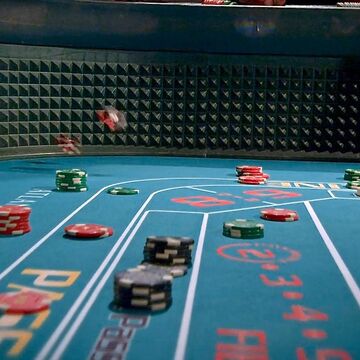Snake Eyes Gambling Term
The origin of the term, of course, comes from diced based games, and dates back as far as ancient Rome. The modern term snake eyes has been used since about the 1930s. So why does the term exist? The likelihood of rolling two ones with a pair of dice is extremely low, one in thirty six, and normally has a negative effect for the dice roller. Snake Eyes - When you roll a two in craps, it is called 'Snake Eyes' - eyes because they look like eyes, snake because they are bad news since the most common bet made on the craps table is the pass line and when 'snake eyes' is thrown on the come out roll a bet on the pass line loses. WWNY COVID shutdown means snake eyes for casino, tribe and local governments By Keith Benman November 20, 2020 at 5:08 PM EST - Updated November 20 at 9:36 PM HOGANSBURG, N.Y.
– by Doug West
© 2003, The Center for Parent/Youth Understanding
Today’s teenager lives in a world sandwiched between childhood and adulthood. Bombarding teens on all sides are adult “forbidden fruit” temptations that are legally out of reach in terms of age, but considered, by many, to be normal “rights of passage” meant to be done “safely” and in “moderation.” Gambling is one such example. Impressionable and impulsive teens are particularly vulnerable to the exciting, enticing and seemingly innocuous entertainment options presented by gambling.
Today’s culture is increasingly accepting of, and receptive to, gambling. A Gallup poll conducted in the spring of 1999 found that 52% of 13-17 year old teens and 63% of adults approve of gambling. Lottery jackpots and winners receive national attention on a regular basis. Almost every state endorses some form of legalized gambling in order to generate tax revenues. In addition to Las Vegas and Atlantic City, several Indian reservations around the country have built and run casinos. Now, thanks to technology, gambling is branching out onto the Internet, even as Congress attempts to legislatively curb and block its expansion.
Given this backdrop it should come as no surprise that teen gambling is on the rise and is the fastest growing addiction among teens, according to an A&E Investigative Report on teen gambling. Consider these eye-opening facts:

- The A&E report cites a federal study that estimates 7 million teens gamble (www.aande.com).
- Florida researchers found that 70% of 13-17 year old Floridians gambled during their lifetime, with an accompanying association with substance abuse, and an average initiation age of 12.5 (www.aacap.org).
- The National Opinion Research Center at the University of Chicago reports that 28% of 16-17 year olds participated in private betting (www.norc.uchicago.edu).
- The Gallup Organization discovered that 26% of teens said they took part in some form of legal gambling, with 27% betting on professional sporting events and 18% on college games, and that 29% of teen gamblers made their first wager when they were ten years old or younger (www.gallup.com).
- The National Research Council estimates there are 5.7 million problem and 2.2 million pathological adolescent gamblers (http://govinfo.library.unt.edu/ngisc/reports/4.pdf).
- USA Today reported on the trend to entice younger gamblers by using popular cultural figures like Austin Powers on video slot machines (USA Today, 9/26/02).
Teen gambling, as with any other hobby or activity, is a function of time, access, attitude and funds. Teens who have the time are given ample “gateway” opportunities to be introduced to and indoctrinated into gambling. Typically it begins with simple card and dice games. Then, it can move on to lottery tickets, horse tracks, and fantasy sports league competitions. Many kids get involved in weekly football, baseball, and basketball pools that are popular in middle and high schools around the country. Clearly, the most menacing and pernicious opportunity for teens to gamble comes from the Internet because of its easy access, and interactive and anonymous nature.
Teen attitudes are shaped by, and steeped in, the relativistic postmodern cultural landscape, which reflects a mindset that snubs absolute truth in favor of subjective feelings. Here, gambling is viewed not so much as a sin – as with the Las Vegas “Sin City” label – but as a matter of personal preference and choice.
Teens finance their gambling in many ways. They can wager allowances and wages, borrow or steal a parents’ credit card and PIN number, or resort to dealing drugs and/or stealing to support their burgeoning habit. Novice and technologically savvy teens can bypass stated age restrictions on Internet gambling sites by using an alias or creating or assuming an identity to become virtual players.
What can parents, pastors and educators do to combat the growing teen gambling trend?
First, raise awareness about the destructive realities of gambling where real people lose real money, and where casual, fun entertainment can become an obsession and addiction that ultimately consumes and ruins lives. Tell them that gambling is harmful, destructive, and wrong. If the potential for a problem exists, perhaps a visit from a reformed gambler who has overcome their sinful behavior with God’s help might be helpful.

Second, set a consistent and biblical example. Parents play the primary role in modeling healthy and mature attitudes and behaviors for teens in regards to gambling. Youth workers and teachers can support parents and reinforce the message through the power of their example.
Third, know where your teens are, who they are with, and what they are doing. As with any other teen behavior, parental knowledge is a wonderful preventive prescription. And finally, if gambling becomes a problem or addiction, get them help. Check to see if any Christian counselors in your area are competent in dealing with issues related to gambling. You can also check out gamblersanonymous.com or problemgambling.com.
The Center for Parent/Youth Understanding grants permission for this article to be copied in its entirety, provided the copies are distributed free of charge and the copies indicate the source as the Center for Parent/Youth Understanding.
For more information on resources to help you understand today’s rapidly changing youth culture, contact the Center for Parent/Youth Understanding.
Snake Eyes
Virtually everyone is familiar with the term snake eyes, which has become synonymous for meaning a total and complete loss, or landing up in a situation that there is no reasonable way out of. The origin of the term, of course, comes from diced based games, and dates back as far as ancient Rome. The modern term snake eyes has been used since about the 1930s.
So why does the term exist?
The likelihood of rolling two ones with a pair of dice is extremely low, one in thirty six, and normally has a negative effect for the dice roller. Hence, the rare event that generally spelled misery for players gained notoriety, and was named after the resemblance to the dice as a pair of eyes. Interestingly, a pair of sixes is as rare as a pair of ones, and is often a good result for players, but has not gained the same notoriety. In the popular game of craps, the term is most prevalent.
Understanding Craps And Dice Games
In craps a player, referred to as a shooter, is required to roll a pair of dice, hoping to land a seven or eleven in any combination of the two dice. If seven or eleven are rolled, the shooter instantly wins, as well as all spectators who have placed bets on this outcome. If, however, the shooter rolls a two, three, or twelve, it is an instant loss.
Should the shooter roll any other number, besides those mentioned above, that number must be rolled again before a seven is rolled, in order for the shooter to win. So why the emphasis on two aces? As with roulette, players of craps may bet on a specific outcome in order to win. That is to say, the shooter does not have to win in order for bets on the results of the dice to payout. So the shooter may lose, but bet makers may still win, if they bet on the shooter losing.
Snake eyes, however, is a result that is excluded from other betting options, meaning that the result must specifically be bet on in order for any payouts to be made. The same is true for the zero pocket in roulette. Hence, it is extremely unlikely that any bets ever be won with the dice landing on two aces. Plus, even if a bet maker has bet on snake eyes, and wins, the payout is not as much as it should be based on the odds of the occurrence.
House Edge
Snake Eyes Gambling Term Memory Loss
Casinos are not in the business of giving away money, and so gambling games require a house edge, or a statistical number by which the casino always wins. In craps snake eyes represent the house edge, as well as the zero pocket in roulette. A house edge may not seem like a lot, but over time will always add up to revenue for the casino, an enormous amount given how many bets are made in casino in a single night. In craps the house edge, simplified, is about eleven percent. Seemingly not a huge amount. Keep in mind, however, that in traditional European roulette, not the altered American version, the house edge is just under three percent. The real trick of gambling is finding the game with least prevalent version of snake eyes.